These notes are intended to provide a casual sky watcher or someone already into amateur astronomy living in Eastern Australia with a summary of what is happening in the night sky in February 2013. The finder charts have been produced for an observer based in Brisbane (Queensland, Australia) but will be useful for observers elsewhere in Eastern Australia.
Instructions on how to obtain customised satellite viewing information for your location can be found here. If you find this page of interest, you may wish to follow this website automatically using Twitter and the sites RSS Feed.
Planets for February 2013
Jupiter is visible above the North Western horizon as a brilliant star as evening twilight ends. It is the brightest object in the evening sky beside the Moon and can’t be mistaken for anyone else. Mars is lost in the glare of the Sun by mid-month and will become visible in the morning sky in June. Uranus is located very low above the Western horizon at the end of evening twilight and will require a decent finder chart and at least a large pair of binoculars to locate. A telescope and steady viewing conditions will be required to recognise it as disc shaped. Neptune is in conjunction with the Sun and will reappear in the morning sky in March. Saturn rises just after 10.14pm AEST mid-February for locations across South East Queensland. Mercury moves into the evening twilight sky low above the Western horizon but remains too close to the Sun and too low above the horizon to be worth pointing a telescope at. Pluto is located in the morning sky and will require a large telescope, a decent star chart and patience to locate. Confirming that you have located it will require at least two repeat observations. In the morning sky, Venus becomes lost in the glare of the rising Sun mid-month and reappears in the evening sky in May.
Bright comets for February 2013
Comet PANSTARRS (Comet 2011 L4) may be visible above the Western horizon in the bright evening twilight in the second half of February) through binoculars. Use the included finder chart (see 25 February below) as a guide to show you where to look in the latter part of February 2013 for the comet with binoculars. Note that the comet won’t appear as shown in the finder chart to the unaided eye.
Individual sky events (February 2013)
All times AEST
February 2 2013: Daytime occultation of star Spica by the Moon visible from Western Australia. Not visibile from South East Queensland. More information here: http://asa.usno.navy.mil/cgi-bin/occnwdo.cgi?dir=2013/occns&file=occn.2013Feb02.Spica&body=Spica
February 3 2013: 11.56pm Last Quarter Moon
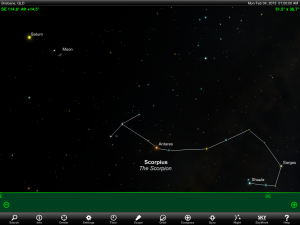
February 4 2013: Moon located to right of Saturn. Early morning sky.
February 5 2013: 3am Asteroid Ceres stationary
February 7 2013: 10pm Moon at perigee 365,318 km from Earth
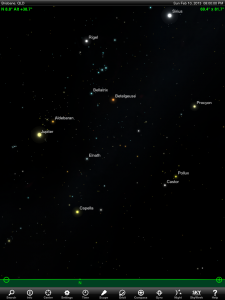
February 10 2013: 3am Comet 2012 F6 (Lemmon) 0.3 degrees South East of Beta Octantis
February 10 2013: 5.20pm New Moon
February 12 2013: Mercury in ascending node
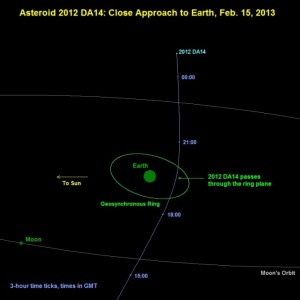
February 16 2013: Asteroid/Minor Planet 2012 DA 14 will be the brightest Near Earth Object to be observed passing our planet to date and will pass only 27,700 km from the Earth’s surface. Go here for further information about this flyby and how to obtain a customised finder chart for your location.
February 17 2013: Mercury at greatest elongation East (18.1 degrees)
February 18 2013: 6.31 am First Quarter Moon
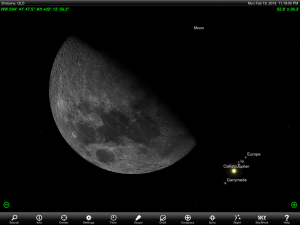
February 18 2013: Moon and Jupiter close. From Southern Australia (including Melbourne, Perth, Hobart and Adelaide) Jupiter will be occulted by the Moon. A separate page about this occultation (including disappearance and reappearance times) can be found here on my site.
February 19 2013: 4pm Moon at apogee 404, 472km from Earth in its orbit
February 19 2013: 9pm Saturn stationary
February 21 2013: Venus at aphelion
February 21 2013: 5pm Neptune in conjunction with Sun
February 23 2013: 5am Mercury stationary
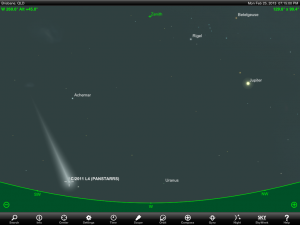
February 25 2013: Pluto 0.1 degree South of star V 4405 Sagittarii. Finder chart and large telescope required.
February 26 2013: 6.26am Full Moon
February 26 2013: Uranus 0.06 degrees North of star 44 Piscium
February 27 2013: Mercury at greatest latitude North
For Further Information
Customised Astronomy & Satellite Viewing information
Information on how to obtain customised astronomy & satellite viewing information for your location can be found here on this website.
References
The information in this post has been prepared using the following references.
Astronomy 2013, Quasar Publishing http://www.quasarastronomy.
Sky Safari Pro Ipad app, http://www.southernstars.com/